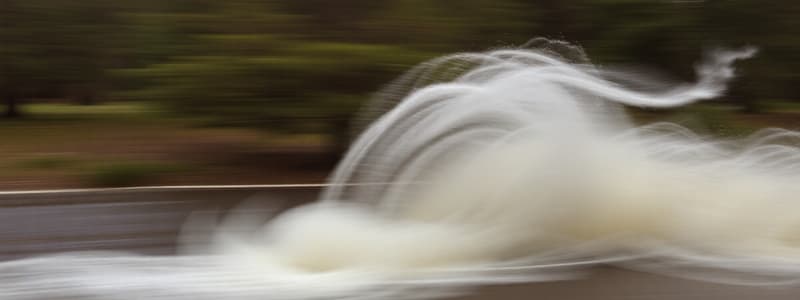Podcast
Questions and Answers
What is the term used to describe the speed of an object at a particular instant?
What is the term used to describe the speed of an object at a particular instant?
- Average speed
- Velocity
- Instantaneous speed (correct)
- Acceleration
An object will continue its state of motion unless acted upon by unbalanced forces.
An object will continue its state of motion unless acted upon by unbalanced forces.
True (A)
Define what average speed is.
Define what average speed is.
Average speed is calculated by dividing the distance travelled by the time taken.
The law that states energy is never created or destroyed is known as the Law of __________.
The law that states energy is never created or destroyed is known as the Law of __________.
Match the following terms to their definitions:
Match the following terms to their definitions:
Which of the following statements describes acceleration?
Which of the following statements describes acceleration?
Friction is an example of an unbalanced force.
Friction is an example of an unbalanced force.
Explain why a car traveling along a straight road has forces acting on it.
Explain why a car traveling along a straight road has forces acting on it.
What is the formula for Newton's Second Law of Motion?
What is the formula for Newton's Second Law of Motion?
An object will change its motion only if acted on by a balanced force.
An object will change its motion only if acted on by a balanced force.
What does the symbol 'g' represent in the potential energy formula?
What does the symbol 'g' represent in the potential energy formula?
In the equation F = ma, F stands for ______, m stands for ______, and a stands for ______.
In the equation F = ma, F stands for ______, m stands for ______, and a stands for ______.
What type of energy does an archer have when drawing a bow?
What type of energy does an archer have when drawing a bow?
Match the following scenarios to their type of energy (K for Kinetic, P for Potential):
Match the following scenarios to their type of energy (K for Kinetic, P for Potential):
What is the kinetic energy of a 1000-kg roller coaster car moving at 20.0 m/s?
What is the kinetic energy of a 1000-kg roller coaster car moving at 20.0 m/s?
Potential energy can be converted to kinetic energy.
Potential energy can be converted to kinetic energy.
Flashcards
Average Speed
Average Speed
The total distance traveled divided by the total time taken.
Velocity
Velocity
Speed with direction.
Instantaneous Speed
Instantaneous Speed
Speed at a specific moment in time.
Acceleration
Acceleration
Signup and view all the flashcards
Unbalanced Force
Unbalanced Force
Signup and view all the flashcards
Potential Energy
Potential Energy
Signup and view all the flashcards
Newton's First Law of Motion
Newton's First Law of Motion
Signup and view all the flashcards
Law of Conservation of Energy
Law of Conservation of Energy
Signup and view all the flashcards
Unbalanced Force and Acceleration
Unbalanced Force and Acceleration
Signup and view all the flashcards
Newton's First Law (Inertia)
Newton's First Law (Inertia)
Signup and view all the flashcards
Newton's Second Law Formula
Newton's Second Law Formula
Signup and view all the flashcards
Kinetic Energy Formula
Kinetic Energy Formula
Signup and view all the flashcards
Potential Energy Formula
Potential Energy Formula
Signup and view all the flashcards
Kinetic Energy
Kinetic Energy
Signup and view all the flashcards
Newton's Third Law
Newton's Third Law
Signup and view all the flashcards
Study Notes
Physical Sciences - Trial Test
- Speed: A measure of the rate at which an object moves over a distance.
- Average Speed: Calculated by dividing the total distance traveled by the total time taken.
- Velocity: A measure of the rate of change in position, including direction.
- Instantaneous Speed: The speed of an object at a specific moment in time.
- Acceleration: The rate at which an object changes its speed. Calculated by dividing the change in speed by the time taken.
- Unbalanced Force: A force that causes a change in the speed or direction of an object's motion.
- Inertia: An object's resistance to changes in motion.
- Newton's First Law of Motion: An object at rest stays at rest and an object in motion stays in motion with the same speed and in the same direction unless acted upon by an unbalanced force.
- Newton's Second Law of Motion: Force equals mass times acceleration (F=ma).
- Newton's Third Law of Motion: For every action, there is an equal and opposite reaction.
- Potential Energy: Stored energy, like energy due to position or configuration.
- Kinetic Energy: Energy of motion. Calculated by 1/2 massspeed².
- Law of Conservation of Energy: Energy cannot be created or destroyed, only transformed from one form to another.
- Force: A push or pull that can change an object's motion. Measured in Newtons (N).
- Mass: The amount of matter in an object. Measured in kilograms (kg).
- acceleration: A change in velocity, calculated as the change in speed divided by the time taken
Applied Forces and Motion
- Forces on a Car: A car moving along a road is affected by forces including thrust, gravity, friction, and the normal force from the road.
- False Statement: A statement that a car traveling on a straight road has no forces acting on it is false because of thrust from the engine, resistive force from air, and friction with the road.
Example Calculations
- Average Speed (km/h): The sample data shows calculations for average speed.
- Calculating acceleration: Formula acceleration = change in velocity / elapsed time, or a = Δv/Δt.
Potential and Kinetic Energy
- Potential Energy: Gravitational potential energy (PE) is calculated as PE = mass × 9.8m/s² × height, where height is in meters. Example calculation in the given text.
- Kinetic Energy: KE=1/2 × mass × velocity² (where velocity is in meters per second). Example calculation. Example data given.
Additional Concepts
- Free Body Diagrams: Represent forces acting on an object.
- Circular Motion: An example of acceleration.
- Energy Conversions: Examples of potential energy changes and kinetic energy changes are demonstrated in calculations.
Studying That Suits You
Use AI to generate personalized quizzes and flashcards to suit your learning preferences.




